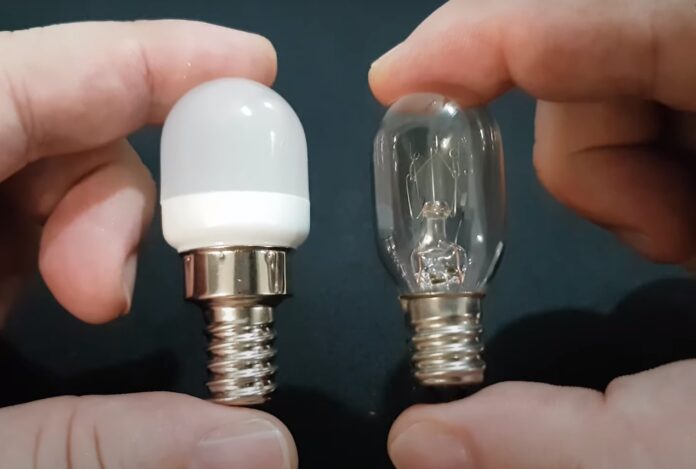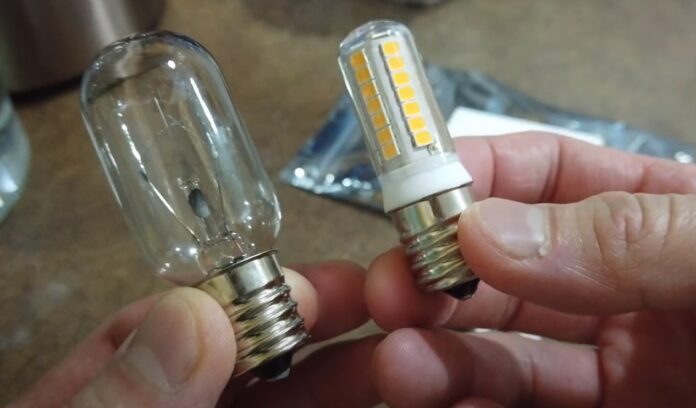Hello, readers! As a licensed electrician with years under my belt working on a variety of lighting projects, one question that’s been popping up more frequently lately is about LED lights in refrigerators.
You’d think lighting a fridge would be straightforward, but as with many things in our profession, it’s not that simple. So, let’s talk about the fascinating world of LED fridge light bulbs and see if they’re worth the hype.
LED Technology in a Nutshell

To truly understand how LED fridge light bulbs work, it’s essential to start with the foundation. Let’s check out the basics of LED technology.
Light Emitting Diodes
LEDs, or Light Emitting Diodes, are a significant leap forward from traditional lighting solutions like incandescent and fluorescent bulbs.
Instead of heating a filament or gas to produce light, they create light when an electrical current passes through a semiconductor material.
This process is far more energy-efficient and produces less heat, making LEDs a favorite for many applications, including household lighting.
Why LEDs are Different from Traditional Bulbs
While incandescent bulbs produce light by heating a filament and fluorescent lamps work by exciting a gas, LEDs don’t rely on these methods.
As a result, LEDs have a longer lifespan, consume less energy, and are more durable.
Moreover, their compact size and ability to function in a wide range of temperatures make them an attractive option for various applications, including those in a confined, cool space like a refrigerator.
Advantages of Using These Bulbs in Refrigerators

With an understanding of LED technology under our belts, let’s see why LEDs are becoming a popular choice for fridge lighting.
Efficiency and Longevity
For starters, LEDs consume a fraction of the energy that conventional fridge bulbs use. This efficiency can lead to noticeable savings in your electricity bill over time. Additionally, LEDs can last up to 25 times longer than incandescent bulbs.
When placed in a fridge, which is frequently opened and closed, this durability ensures that replacements will be few and far between, saving homeowners both time and money.
Safety and Temperature Benefits
Traditional incandescent bulbs can get scorching. In a confined space like a fridge, this heat can impact the internal temperature and possibly affect the stored food’s freshness.
LEDs, on the other hand, run cool. This ensures that the fridge’s cooling system doesn’t have to work overtime to counteract the heat emitted by the bulb.
Moreover, with their sturdy design, LED bulbs are less likely to break, which is essential in a space where shattered glass could contaminate food.
Potential Drawbacks and Considerations

While LEDs offer a myriad of benefits, like any product, they come with a set of considerations. Let’s explore some potential drawbacks of using LED fridge bulbs.
Cost Implications
Initially, LED fridge bulbs might be more expensive than traditional alternatives. This upfront cost can deter some homeowners.
However, it’s essential to consider the long-term benefits, like energy savings and fewer replacements, which can offset the initial investment over time.
Compatibility Issues
Not all refrigerators are designed to work with LED bulbs. Some older models may not be compatible, or they may require additional modifications to fit and function correctly with LEDs.
Before making the switch, it’s crucial to check the refrigerator manufacturer’s recommendations or consult with a professional like yours truly, to ensure a seamless transition.
Color Temperature and Your Fridge’s Aesthetics

Beyond functionality, there’s an aesthetic component to consider. The visual appeal of your fridge’s interiors can be influenced significantly by the color temperature of your LED bulb.
Color Temperatures
Color temperature, measured in Kelvins (K), determines the warmth or coolness of light emitted by a bulb. Lower values, like 2700K, produce a warmer, yellowish light reminiscent of incandescent bulbs.
Higher values, such as 5000K or more, give off a cooler, blueish-white light. LEDs offer a broad spectrum of color temperatures, allowing homeowners to choose a light that complements their fridge’s interiors and the type of food stored.
Why It Matters in Your Fridge
The color of the light can impact how we perceive the freshness and appeal of the food in our fridges. A crisp, white light might make greens look fresher and more appealing, while a warmer tone might give off a cozy, homey feel.
Depending on personal preferences, one can opt for LEDs that enhance the visual appeal of their food, making meal choices more enticing.
Making the Switch: Practical Tips

If you’re convinced about transitioning to LED fridge bulbs, here are some practical tips to guide you through the process.
Selecting the Right Bulb
As emphasized before, not all bulbs are compatible with every refrigerator model. Always check the socket type and voltage requirements before purchasing.
Additionally, consider the bulb’s size and shape to ensure it fits comfortably within your fridge’s designated bulb space without obstructing any compartments.
Installation and Precautions
Installing an LED fridge bulb is typically as simple as screwing in a regular bulb. However, always ensure the fridge is unplugged during the process to avoid any electrical mishaps.
If the bulb doesn’t light up, check if it’s screwed in properly or consult the manufacturer’s guidelines. And, as always, if in doubt, reach out to a professional electrician.
Eco-Friendly Aspects

Sustainability is a growing concern for many, and choosing LED bulbs can play a role in making your household more environmentally friendly.
Reduced Carbon Footprint
LED bulbs, in general, consume less energy than traditional bulbs. By opting for LED fridge bulbs, you’ll be lowering your refrigerator’s energy consumption.
This reduced energy usage translates to fewer greenhouse gas emissions, which directly contributes to a smaller carbon footprint.
Less Waste and Reduced Toxicity
With their longer lifespan, LED bulbs need to be replaced less frequently, leading to less waste in landfills.
Additionally, unlike some fluorescent bulbs, LEDs don’t contain hazardous materials like mercury, making them a safer choice for the environment when they finally do reach the end of their life cycle.
FAQs
How do LED fridge bulbs handle the cold environment inside a refrigerator?
They are particularly well-suited for cold environments. Unlike some other bulb types, they don’t experience a decline in performance due to cold temperatures.
In fact, the cool environment of a fridge can actually enhance the lifespan and efficiency of an LED bulb.
Is there a noticeable difference in brightness between traditional and LED fridge bulbs?
Yes, LED bulbs often provide clearer and brighter illumination compared to many traditional bulbs.
Moreover, with LEDs, you have the flexibility to choose from various brightness levels and color temperatures to achieve the desired ambiance inside your fridge.
Do LED fridge bulbs emit any radiation that could harm the food?
No, they do not emit any harmful radiation. They operate without giving off ultraviolet (UV) or infrared (IR) radiation, which ensures the safety and integrity of the food stored in your refrigerator.
Can I use any LED bulb in my fridge, or are there specific fridge bulbs?

While many of these bulbs might physically fit into the socket of a refrigerator, it’s best to use LEDs specifically designed for fridge use.
These are tailored to handle the humidity, temperature variations, and specific needs of a refrigerator environment.
What happens if an LED fridge bulb gets wet or is exposed to high humidity?
LED bulbs are generally more resistant to moisture and humidity compared to traditional bulbs.
However, it’s essential to ensure that the bulb’s casing and connectors remain dry to avoid any short circuits or reduced lifespan. Bulbs specifically designed for fridges often come with added protection against moisture.
Are LED fridge bulbs available in smart variants that I can control with my phone or smart home system?
Yes, as technology advances, there are smart bulbs available that can be integrated into your smart home system, allowing you to control brightness or even color from your phone or through voice commands.
However, ensure compatibility with your refrigerator model before opting for such bulbs.
Final Words
There you have it, folks! LED fridge bulbs indeed come with a host of advantages, from energy efficiency to enhanced safety.
However, always remember to weigh these benefits against potential drawbacks, like cost and compatibility. As an electrician who’s seen the evolution of lighting firsthand, I believe LEDs represent the future of fridge lighting.
But, as with any change, it’s essential to make informed decisions. I hope this article has resolved some of the nuances of fridge lighting for you.




